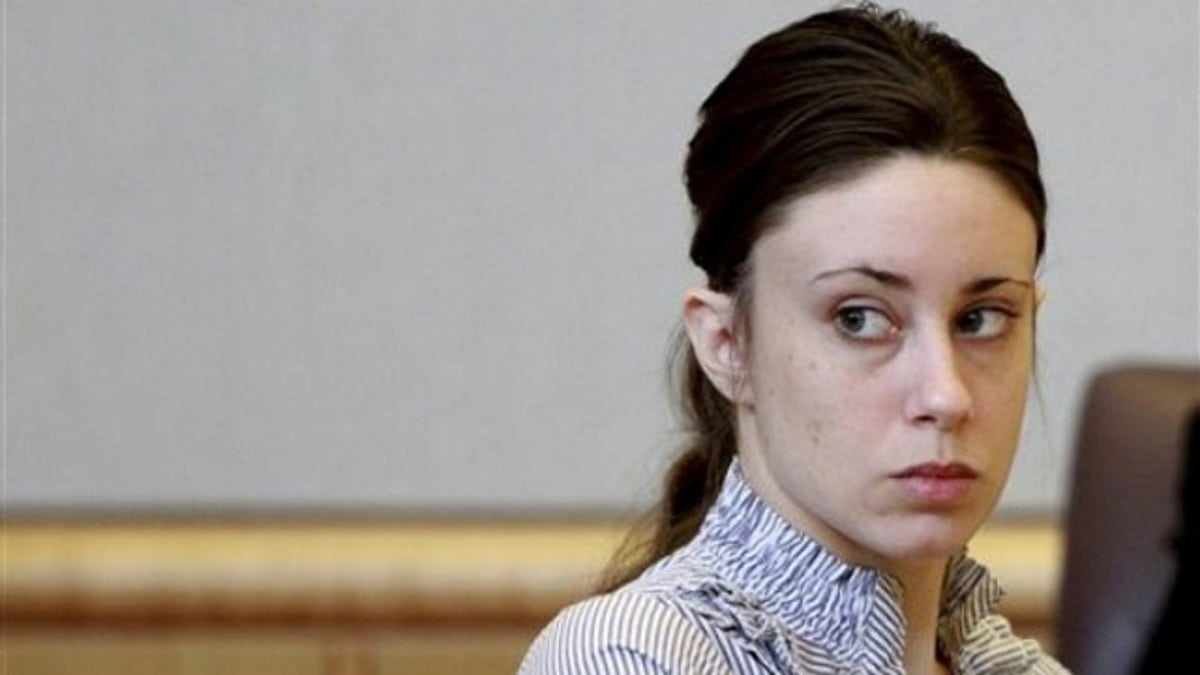
May 13: Casey Anthony reacts during her trial in the courtroom at the Pinellas County Criminal Justice Center on the fifth day of jury selection in her trial, in Clearwater, Fla. (AP).
ORLANDO, Fla. -- No witnesses saw what happened to 2-year-old Caylee Anthony, and only her killer knows exactly how she died. No one has confessed. So when her mother, Casey Anthony, goes to trial Tuesday on murder charges, the jury's decision will likely come down to forensic evidence.
Prosecutors plan to have jurors smell the odor from her car, present evidence of chloroform in the 1998 Pontiac Sunfire and present photos that they say show her partying with friends after her daughter disappeared. They also likely will seek testimony from a botanist, a hair and fiber examiner from an FBI lab, and a cadaver dog handler.
Anthony's defense attorneys plan to present testimony from an expert in the new field of touch DNA, an entomologist and Dr. Henry Lee, a famous forensics expert who has worked on the O.J. Simpson, Phil Spector and JonBenet Ramsey cases.
"It is going to be a battle of experts," said Karin Moore, a law professor at Florida A&M University in Orlando. "They don't have a confession. They don't have an eyewitness. They don't have direct evidence. They are relying on forensic science that is circumstantial, at best."
Opening statements were set for Tuesday following a marathon 11 days of jury selection in Clearwater, Fla. Jurors were picked outside of Orlando because of publicity surrounding the case, and they will be sequestered for nearly two-month trial.
Casey Anthony, 25, is charged with first-degree murder in her daughter's death. If convicted, she could be sentenced to death. She also is charged with aggravated child abuse, aggravated manslaughter of a child and providing false information to law enforcement. She has pleaded not guilty and has said a babysitter kidnapped Caylee.
Hundreds of volunteers searched for Caylee after she was reported missing in July 2008. The girl's decomposed remains were found five months later by a meter reader in woods not far from where she lived with her mother and grandparents. Detectives said residue of a heart-shaped sticker was found on duct tape over the mouth of her skull. The local medical examiner could not determine how Caylee died, and an autopsy report said Caylee's bones showed no signs of trauma.
Anthony waited a month before telling her mother that Caylee had disappeared, and only after Anthony's parents, George and Cindy, recovered from the towing lot a car with a foul odor that Casey Anthony had been driving the past month. When Cindy Anthony called 911 to report her granddaughter missing, she told the dispatcher, "There's something wrong. I found my daughter's car today and it smells like there has been a dead body in the damn car."
That odor will be a key element during trial.
Anthony's defense attorneys claim the odor came from a bag of garbage left in the car for almost three weeks. But prosecutors plan to introduce results from a novel test never used before in a U.S. trial that can identify odors coming from a decomposing body. The test showed the presence of compounds consistent with decomposition, although it couldn't show how much. Defense attorneys unsuccessfully tried to keep the new test out of trial, claiming the science used wasn't mature enough to draw any conclusion.
Detectives cut a piece of trunk liner from the car, placed it in a tin can and sealed it. During jury selection, prosecutors indicated they will ask jurors to get a whiff of the odor from the can. Circuit Judge Belvin Perry warned prosecutors that they will have to proceed carefully because jurors only evaluate the testimony of other witnesses, he said.
"The purpose isn't for the jury to determine decomposition," said prosecutor Jeff Ashton. "The purpose is to judge whether it's garbage."
Defense attorneys claim that investigators destroyed their only hope of showing the smell was from garbage by airing out the contents of the garbage bag.
"The garbage evidence in this case has become increasingly important given the fact that law enforcement found no items that can determine that a dead body was ever in the trunk of the vehicle," defense attorneys said in a filing.
Prosecutors may also use Anthony's own words and photos against her. Before her arrest, she repeatedly lied to investigators about where she worked and even led them to Universal Studios before admitting she didn't have a job there.
The judge ruled Anthony's statements could be used during trial, despite objections from her attorneys. He withheld a decision regarding the alleged party photos.
Meanwhile, defense attorneys plan to call on their own team of experts. They hope to convince jurors it was impossible for Anthony to have left the body in the woods because she would have been in jail at the time their experts believe the body was left at the scene. They have a botanist who can testify about plant growth found around the remains. They also have an entomologist who they hope can refute prosecutors' own bug expert, who claims that flies associated with decomposition were found in her car's trunk.
Defense attorneys hope conflicting forensic evidence and interpretations by experts raise questions in jurors' minds. Defense attorney Jose Baez made a point of telling potential jurors they should take those conflicting interpretations to heart.
"It can be means to conclude reasonable doubt exists in this case," he said.

